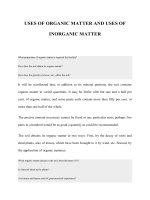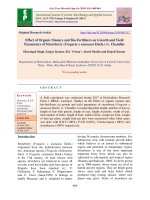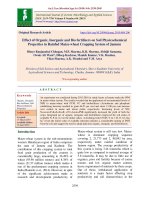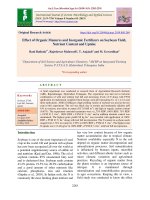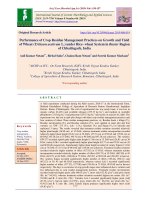Performance of coriander (Coriandrum sativum L.) to different sources of organic phosphorus and PSB on growth and seed yield
Bạn đang xem bản rút gọn của tài liệu. Xem và tải ngay bản đầy đủ của tài liệu tại đây (150.04 KB, 6 trang )
Int.J.Curr.Microbiol.App.Sci (2019) 8(8): 2584-2589
International Journal of Current Microbiology and Applied Sciences
ISSN: 2319-7706 Volume 8 Number 08 (2019)
Journal homepage:
Original Research Article
/>
Performance of Coriander (Coriandrum sativum L.) to Different Sources of
Organic Phosphorus and PSB on Growth and Seed Yield
Subhas Sannappanavar, G. Gangadhar Eswar Rao* and M. Vasundhara
Research Institute on Organic Farming, University of Agricultural Sciences, GKVK,
Bengaluru-560065, India
*Corresponding author
ABSTRACT
Keywords
Organic
phosphorus, neem
cake, PSB,
Coriander
Article Info
Accepted:
22 July 2019
Available Online:
10 August 2019
Field experiment was conducted during rabi-2018 at Research Institute of
Organic Farming field unit, UAS, GKVK, Bengaluru to study the different
sources of organic phosphorus and PSB on growth, seed yield and essential
oil content in coriander laid out in Randomized Complete Block Design
with 10 treatments replicated thrice and the variety used was Co Cr-4.
Results of the experiment revealed that phosphorus at 40 kg ha-1 applied
through neem cake + PSB at 2 kg ha-1 recorded significantly higher seed
yield (665 kg ha-1) and essential oil yield (4.72 kg ha-1). These results are
attributed to enhanced growth parameters like plant height (81.6 cm),
primary branches per plant (5.40), leaf area (287.33 cm2 plant-1), dry matter
production per plant (7.07 g) and yield attributes like number of umbels per
plant (19.20), number of umbellets per umbel (6.28) and number of seeds
per umbel (28.97). Whereas, phosphorus at 40 kg ha-1 applied through rock
phosphate results in lower seed and essential oil yield (511 and 3.47 kg ha1
, respectively).
Introduction
World population is increasing day by day.
Hence, it is necessary to stabilize agricultural
production and increase it further in a
sustainable manner. Thus, there is need to
maintain a natural balance at all cost for
existence of natural life and property. Organic
agriculture system as sustainable production
management system that provides long term
benefits to people and the environment. Seed
spice are annual herbs, whose dried seeds or
fruits are used as spices. They are natures gift
to human kind as they add flavour to our food.
In addition, they also have preservative and
medicinal values (Annon, 2015). Coriander
(Coriandrum sativum L.) is one of the
important vegetables, spice and aromatic
annual herb with small seeds belonging to the
family Apiaceae. Coriander gives two primary
products viz., fresh green herb and seed spice
that are used for flavouring purposes.
2584
Int.J.Curr.Microbiol.App.Sci (2019) 8(8): 2584-2589
Coriander fresh leaves are being used in
cooking, flavouring etc., and seeds are being
used for preparing value added products such
as coriander powder, condiment, oleoresin,
essential oil, medicine and cosmetic
industries. India is the largest produces,
consumer and exporter of coriander in the
world. In India, the major coriander growing
states are Rajasthan, Gujarat, Madhya
Pradesh, Karnataka, Tamil Nadu, Andhra
Pradesh and Uttar Pradesh (Kader et al.,
1985). The area under coriander cultivation in
India is 5.8 lakh hectares and production of
584.98 thousand metric tonnes and
productivity of 908 kg ha-1. Phosphorus has
played a significant role in photosynthesis,
respiration, energy storage, cell division and
several other processes like seed formation,
hastening maturity and also contributes to
disease resistance in coriander (Pareek and
Sethi, 1985). Added phosphorus undergo
fixation due to complex exchanges within the
soil (Altomare et al., 1999). Several Psolubilizing microorganisms have the ability
to convert insoluble phosphorus into soluble
forms. PSBs solubilize insoluble form of
phosphate by acidification, chelation and also
by organic acid production (Chung et al.,
2005). In the recent days, more emphasis has
been given on the possibility of utilizing
indigenously available FYM, neem cake,
poultry manure, rock phosphate and biogas
slurry to meet out the phosphorus requirement
crops with addition of PSB.
biogas slurry along with PSB on growth seed
yield of coriander during rabi- 2018. The
experiment was laid out in Randomized
Completely Block Design and treatments were
replicated thrice. The net plot size was 3.3 m ×
3.1 m (10.23 m2) with spacing of 30 × 10 cm.
Recommended dose of nutrients for coriander
is 60:40:20 N:P2O5:K2O kg ha-1 and nutrients
were supplies through organic manures on the
basis of phosphorus equivalent. There were 10
treatments with different organic phosphorus
sources and PSB viz., T1 - Phosphorus at 40
kg ha-1 applied through FYM, T2 - Phosphorus
at 40 kg ha-1 applied through FYM + PSB at 2
kg ha-1. T3 - Phosphorus at 40 kg ha-1 applied
through Rock phosphate, T4 - Phosphorus at
40 kg ha-1 applied through Rock phosphate +
PSB at 2 kg ha-1, T5 - Phosphorus at 40 kg ha-1
applied through poultry manure, T6 Phosphorus at 40 kg ha-1 applied through
poultry manure + PSB at 2 kg ha-1, T7 Phosphorus at 40 kg ha-1 applied through
Neem cake, T8 - Phosphorus at 40 kg ha-1
applied through Neem cake +PSB at 2 kg ha-1,
T9 - Phosphorus at 40 kg ha-1 applied through
biogas slurry, T10 - Phosphorus at 40 kg ha-1
applied through biogas slurry + PSB at 2 kg
ha-1. Organic manures were incorporated into
the soil, three weeks prior to sowing. Soil of
the experimental site was red sandy loam with
a pH of 6.73, EC 0.22 ds m-1, low in organic
carbon (0.41%) and medium in available
nitrogen (290 kg ha-1), phosphorus (29.50 kg
ha-1) and potassium (224 kg ha-1).
Materials and Methods
Results and Discussion
A field experiment was conducted at research
and demonstration block of Research Institute
on Organic Farming, University of
Agricultural Sciences, Gandhi Krishi Vignana
Kendra, Bengaluru which is situated in
Eastern dry zone of Karnataka. The
experiment was conducted to study different
organic phosphorus sources viz., FYM, rock
phosphate, poultry manure, neem cake and
Effect of different organic phosphorus and
PSB on growth and seed yield of coriander
The data presented in the (Table 1) revealed
that significantly higher growth parameters of
the coriander recorded with T8 (Phosphorus at
40 kg ha-1 applied through neem cake + PSB
at 2 kg ha-1) i.e., plant height (81.64 cm),
number of primary branches (5.40), leaf area
2585
Int.J.Curr.Microbiol.App.Sci (2019) 8(8): 2584-2589
(287.33 cm2) and dry matter production (7.07
g plant-1). This was followed by T10
(phosphorus at 40 kg ha-1 applied through
biogas slurry + PSB at 2 kg ha-1), T6
(phosphorus at 40 kg ha-1 applied through
biogas slurry + PSB at 2 kg ha-1) and T2
(phosphorus at 40 kg ha-1 applied through
biogas slurry + PSB at 2 kg ha-1. Application
of phosphorus to coriander significantly
improves the growth parameters of the crop
like plant height, number of primary branches,
total leaf area as well as total dry matter
production. An adequate supply of phosphorus
during early life cycle of plant is important in
laying down its reproductive parts. It was
associate with stimulated root development,
increased stalk and stem strength. The
extensive root system of the coriander crop
helps in exploiting the more amount of
nutrients as well as water from the soil (Javiya
et al., 2017). These outcomes were in
conformity with Naghera et al., 1997 and
Nandal et al., 2010. Application of
phosphorus along with PSB helps in sufficient
supply of macro and micro nutrients through
neem cake (Shivakumar et al., 2011).
Application of organic manures influenced the
physiological processes, facilitated early leaf
initiation and resulted in a net increase in leaf
area. The increased leaf area may have
facilitated the capture of more solar energy for
metabolic use, more CO2 fixation and
produced greater photosynthates. It has a
positive effect on biomass production and
subsequently improved plant height and
primary branches (Singh et al., 2009).
Results obtained in the present field
experimental trial showed that significantly
higher seed yield (665 kg ha-1) was produced
in T8 (phosphorus at 40 kg ha-1 applied
through neem cake + PSB at 2 kg ha-1) as
compared to the other treatments. This was
followed by T10 (phosphorus at 40 kg ha-1
applied through biogas slurry + PSB at 2 kg
ha-1), T6 (phosphorus at 40 kg ha-1 applied
through biogas slurry + PSB at 2 kg ha-1) and
T2 (phosphorus at 40 kg ha-1 applied through
biogas slurry + PSB at 2 kg ha-1) (630, 626
and 624 kg ha-1, respectively). Whereas, lower
seed yield (511 kg ha-1) was recorded with
phosphorus at 40 kg ha-1 applied through rock
phosphate (Table 2). The higher yield is due to
the higher yield parameters of the coriander
i.e., number of umbels per plant (19.20),
number of umbellets per umbel (6.28) and
number of seeds per umbel (28.97). Lower
yield parameters of the coriander were
recorded with phosphorus at 40 kg ha-1
applied through rock phosphate alone.
Table.1 Effect of different organic phosphorus sources and PSB on growth parameters of
coriander
Treatment
no.
T1
T2
T3
T4
T5
T6
T7
T8
T9
T10
SE.m±
CD at 5%
Plant height
(cm)
64.16
74.31
61.19
63.28
67.45
76.04
71.40
81.64
68.67
78.99
3.37
10.02
No. of primary
branches
4.10
4.60
3.90
4.00
4.15
4.85
4.40
5.40
4.28
5.10
0.21
0.64
2586
Total leaf area
(cm2 plant-1)
244.58
257.33
223.67
232.67
242.67
274.00
250.50
287.33
258.67
278.67
12.24
36.65
Total dry matter
production (g plant-1)
5.02
6.28
4.35
4.80
5.11
6.38
5.42
7.07
5.24
6.52
0.27
0.80
Int.J.Curr.Microbiol.App.Sci (2019) 8(8): 2584-2589
Table.2 Effect of different organic phosphorus sources and PSB on yield parameters of coriander
Treatment No. of umbels
no.
per plant
T1
T2
T3
T4
T5
T6
T7
T8
T9
T10
SE.m±
CD at 5%
15.09
17.48
14.39
14.88
15.86
17.88
16.79
19.20
16.15
18.58
0.79
2.36
No. of
umbellets
per umbel
5.15
5.56
4.80
5.10
5.43
5.60
5.27
6.28
5.33
5.80
0.26
0.77
In the present investigation, the differences in
the various yield components which lead to
significant yield differences might be traced
back to significant variation in production of
dry matter and its accumulation in plant.
Application of neem cake along with PSB
enhances the yield parameters of coriander.
The higher assimilates accumulation in these
treatments reflected in higher number of
umbels per plant, number of umbellets per
plant and number of seeds per umbel, this
indicating their yield superiority. These
results were in conformity with those of
Thomas Abraham and Lal (2003). The
increase in yield parameters through organic
nutrient management might be due to
enhanced uptake of N, P and K, which results
in better vegetative growth, while phosphorus
improves the root growth and productive
ability of the coriander. Neem cake has ability
to improves the soil structure and biological
activity of soil. Further, by improving the
structure of the soil by more aggregation,
water holding capacity and air permeability
are increased by neem cake application along
with PSB. This comprehensive change in soil
might have improved the vegetative growth
No. of
seeds per
umbel
23.00
25.60
22.33
24.20
23.73
26.57
24.90
28.97
23.50
27.67
1.19
3.53
1000 seed
test weight
(g)
9.45
9.92
9.02
9.17
9.20
10.20
9.32
10.90
9.07
10.60
0.46
NS
Seed yield
(kg ha-1)
547
624
511
542
565
626
576
665
571
630
27.76
84.47
and yield parameters. Similar results were
obtained in coriander (Sahu et al., 2014,
Vasmate et al., 2008), fennel (Abbou et al.,
2004) and fenugreek (Singh, 2013).
Integration of organics and biofertilizers
might have increased yield contributing
attributes. Similar results of improvement in
growth and yield parameters were also
observed by Patil et al., (2012a) in chickpea
and Sharada (2013) in green gram- Rabi
sorghum cropping system.
From the present study, it can be concluded
that application of organic phosphorus
sources and along with PSB helps higher
growth and yield of coriander. Among the
different sources used in the experiment,
phosphorus at 40 kg ha-1 applied through
neem cake + PSB at 2 kg ha-1 are beneficial in
improving growth and yield of coriander crop.
References
Abbou, M. A. H., El Sayed, A. A., Badran, F.
S. and El Deen, R. M. S., 2004, Effect
of planting density and chemical and
biofertilization on vegetative growth,
2587
Int.J.Curr.Microbiol.App.Sci (2019) 8(8): 2584-2589
yield and chemical composition of
fennel (Foeniculum vulgare). Ann.
Agric. Sci., 42: 1902-1922.
Altomare, C., Norvell, W. A., Bjorkman, T.
and Harman, G. E., 1999, Solubilization
of phosphates and micronutrients by
plant-growth promoting and biocontrol
fungus Trichoderma harzianum Rifai.
Appl. Environ. Microbiol., 65 pp. 29262933.
Anonymous, 2015, (ICAR-NRCSS). http://
nrcss.res.in.
Chung, H., Park, M., Madhaiyan, M.,
Seshadri, S., Song, J., Cho, H. and Sa,
T., 2005, Isolation and characterization
of phosphate solubilizing bacteria from
the rhizosphere of crop plants of Korea,
Soil Biol. Biochem., 37:1970-1974.
Javiya, P. P., Solanki, J. N. Kaneria, S. C. and
Rupareliya, V. V., 2017, Response of
coriander (Coriandrum sativum L.) to
nitrogen and phosphorus in South
Saurashtra condition. Int. J. Pure App.
Biosci., 5(4): 860-866.
Kader, M., Abdul Khader, J. and
Muthuswami, S., 1985, Coriander a
crop of good prospects for Tamil Nadu.
Indian Cocoa Arecanut Spices J., 8(1):
5-6.
Naghera, R. P., 1997, Response of coriander
to different sowing date under varying
levels of nitrogen and phosphorus.
M.Sc. (Agri.) Thesis (Unpublished).
Gujarat Agric. Univ., Junagadh.
Nandal, J., Dahiya, M. S., Gupta, V., Bamel,
J. and Telhan, S. K., 2010, Response of
spacing, phosphorus levels and cutting
of leaves on growth and yield of
coriander. Indian J. Horti., 67: 271-275.
Pareek, S. K. and Sethi, K. L., 1985,
Response to fertilization in coriander.
Indian Perfumer. 29:225-228.
Patil, S. V., Halikatti, S. I., Gurumurthy S. B.
and Lokesh. M. S., 2012a, Influence of
integrated organic nutrient management
practices on quality parameters of
chickpea grown in Vertisol of Northern
dry zone of Karnataka. Int. J. For. Crop
Improv., 3(1): 8-12.
Sahu, R. L., Sahu, H. and Kumar, S., 2014,
Effect of application of inorganic
fertilizers and bio-fertilizers on growth
components and yield traits of coriander
(Coriander sativum L.). Int. J. Agric.
Sci., 10: 433-436.
Sharada, 2013, Studies on nutrient
management practices through organics
in greengram – Rabi sorghum cropping
system. M.Sc. (Agri.) Thesis, Univ.
Agric. Sci., Raichur (India).
Shivakumar, B. C., Girish, A. C., Balakrishna
Gowda, Vijaya Kumar, G. C.,
Mallikarjuna Gowda, A. P. and
Thimmegowda, M. N., 2011, Influence
of Pongamia, Mahua and Neem cakes
on finger millet productivity and soil
fertility. J. Applied and Natural Sci.,
3(2): 274-276.
Singh, B., Masih, M. R. and Choudhari, R. L.,
2009, Evaluation of P and S enriched
organic manures and their effect on seed
yield and quality of coriander
(Coriandrum sativum). Int. J. Agric.
Sci., 5(1): 18-20.
Singh, S. P., 2013, Response of bio-fertilizer
Azospirillum on growth and yield of
fenugreek (Trigonella foenum graecum
L.) cv. Rajendra kanti. Int. J. Agric.
Sci., 9: 151-162.
Thomas Abraham and Lal, R. B., 2003,
Enhancement of productivity potential
of greengram (Vigna radiata L.)
through integrated nutrient management
(INM) in a legume-based cropping
system. Madras Agric. J., 90(7-9): 431437.
Vasmate, S. D., Patil, R. F., Manolikar, R. R.,
Kalabandi, B. M. and Digrase, S. S.,
2008, Effect of spacing and organic
manures on seed of coriander
(Coriandrum sativum L). The Asian J.
Horti., 3: 127-129.
2588
Int.J.Curr.Microbiol.App.Sci (2019) 8(8): 2584-2589
How to cite this article:
Subhas Sannappanavar, G. Gangadhar Eswar Rao and Vasundhara M. 2019. Performance of
Coriander (Coriandrum sativum L.) to Different Sources of Organic Phosphorus and PSB on
Growth and Seed Yield. Int.J.Curr.Microbiol.App.Sci. 8(08): 2584-2589.
doi: />
2589
